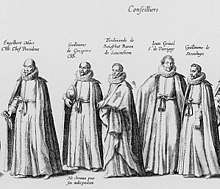Guillaume de Steenhuys
Guillaume de Steenhuys, Lord of Flers (1558–1638) was a noble magistrate and diplomat in the Spanish Netherlands.
Guillaume de Steenhuys | |
|---|---|
 Privy councillors in the funeral cortege of Archduke Albert (1622), Steenhuys at far right | |
| councillor of the Great Council of Mechelen | |
| In office 1601–1638 | |
| Monarch | Albert VII, Archduke of Austria (1598–1621) Philip IV of Spain (1621–1665) |
| Governor General | Isabella Clara Eugenia (1621–1633) Cardinal-Infante Ferdinand of Austria (1633–1641) |
| Personal details | |
| Born | October 8, 1558 Lannoy |
| Died | April 30, 1638 (aged 79) Brussels |
| Resting place | Dominican church, Brussels |
| Spouse(s) | Marguerite de Gottignies |
| Children | Philippe-Guillaume de Steenhuys |
| Parents | Jean de Steenhuys |
| Education | civil law |
| L. Bril, "Steenhuys (Guillaume de)", Biographie Nationale de Belgique, vol. 23 (Brussels, 1921–1924), 156–158. | |
Family
Steenhuys was born at Lannoy on 8 October 1558, son of Jean de Steenhuys, Lord of Linghen, and Charlotte de Preys.
In 1591 he married Marguerite de Gottignies, daughter of Lancelot, Lord of la Haye. They had two children:
- Marie de Steenhuys; married to Philippe de Spanghen, Lord of Ter Liest.
- Philippe-Guillaume de Steenhuys, who succeeded his father and became Baron of Poederlee; further descendants.
Career
He obtained the degree of licentiate in law and on 7 June 1601 he was appointed a councillor of the Great Council of Mechelen, on 3 May 1611 councillor and master of requests of the Brussels Privy Council, and in 1613 commissioner in fiscal cases. He was an important advisor on monetary law.[1]
In June 1617 and January 1619 he travelled to Antwerp and Leuven to investigate the publication of Corona Regia, a scandalous libel of James VI and I.[2] In 1618–1619 he undertook a mission to the King of France, and in 1620 to Ambrogio Spinola in the Rhine Palatinate. On 8 May 1622 he was appointed to the Council of State and in October of the same year he was discharged as a privy councillor and despatched to assist the Spanish delegation at the Diet of Regensburg (1623). The same year he was knighted.
He returned to Brussels in April 1623. On 1 January 1627 he was appointed to the Admiralty council.[1]
Steenhuys died at Brussels on 30 April 1638 and was buried in the Dominican church in the city.[1]
References
- L. Bril, "Steenhuys (Guillaume de)", Biographie Nationale de Belgique, vol. 23 (Brussels, 1924), 756-758.
- Jules Finot, Inventaire sommaire des archives départementales antérieures à 1790. Nord: archives civiles, series B, vol. 6, Chambre des Comptes de Lille, nos. 2788 à 3228 (Lille, 1888), p. 92.